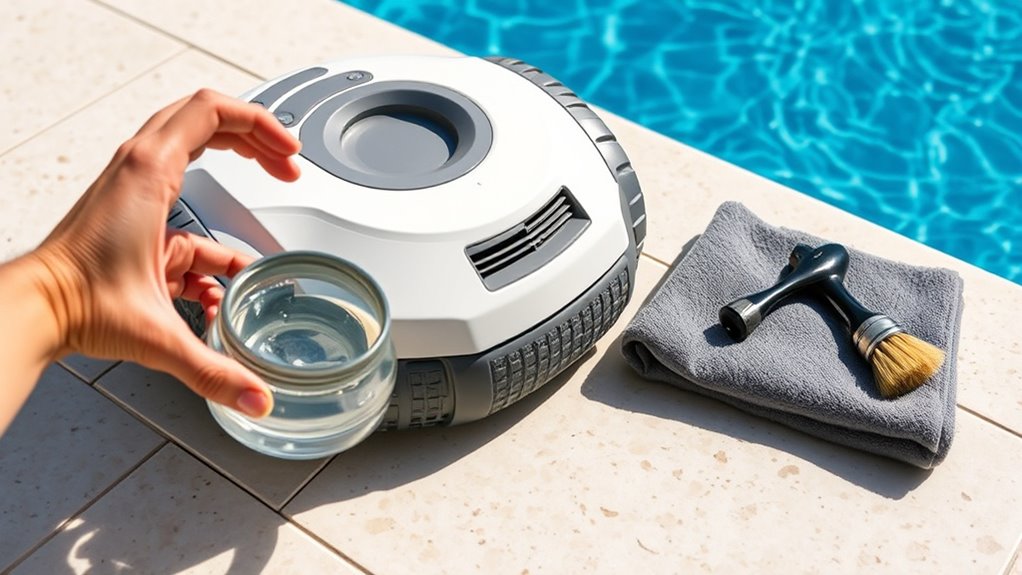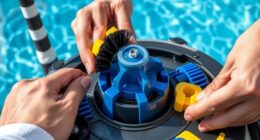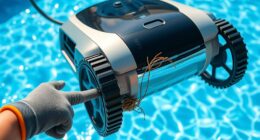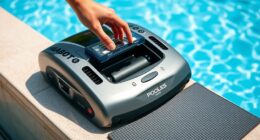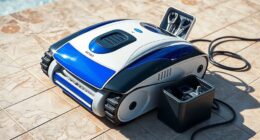To keep your robotic pool cleaner working well, check it regularly for performance issues, unusual noises, or physical damage. Clean or replace filters and scrubbing parts as needed, and inspect the power cords and connections for wear or damage. Schedule routine maintenance like filter cleanings and component checks to prevent problems. For best results, follow manufacturer guidelines, and if you stay attentive to these steps, you’ll discover more ways to keep your cleaner in top shape.
Key Takeaways
- Inspect and clean filters, brushes, and scrubbing components regularly to maintain optimal cleaning performance.
- Check power cords, connections, and the power supply for damage or electrical issues periodically.
- Replace worn or damaged parts, such as brushes and scrubbing pads, using manufacturer-approved components.
- Monitor device behavior and performance for signs of decline or unusual noises, servicing as needed.
- Follow the manufacturer’s routine maintenance schedule to prolong the cleaner’s lifespan and ensure efficiency.
Recognizing Signs That Your Cleaner Needs Servicing

If your robotic pool cleaner isn’t performing as well as it used to, it’s important to recognize the signs that it needs servicing. One common indicator is reduced cleaning efficiency or missed spots, which might signal debris buildup or motor issues. Unusual noises or erratic movements also suggest maintenance is needed. Before attempting DIY tips, always follow safety precautions—disconnect the power supply and wear gloves to avoid injuries. Check for tangled cords or debris caught in brushes, as these can hinder performance. If cleaning the brushes doesn’t resolve the issue, it’s time to inspect internal components or seek professional help. Regularly observing your cleaner’s behavior helps catch problems early, ensuring it continues to keep your pool spotless without unnecessary downtime. Monitoring the suction power and performance metrics can help identify when components are degrading or need replacement. Additionally, reviewing the motor function can reveal if internal parts are wearing out and require servicing. For optimal performance, ensure that the filter system is clean and functioning properly. It’s also helpful to consult the manufacturer’s guidelines for routine maintenance to prolong your cleaner’s lifespan.
Checking and Cleaning the Filter Regularly
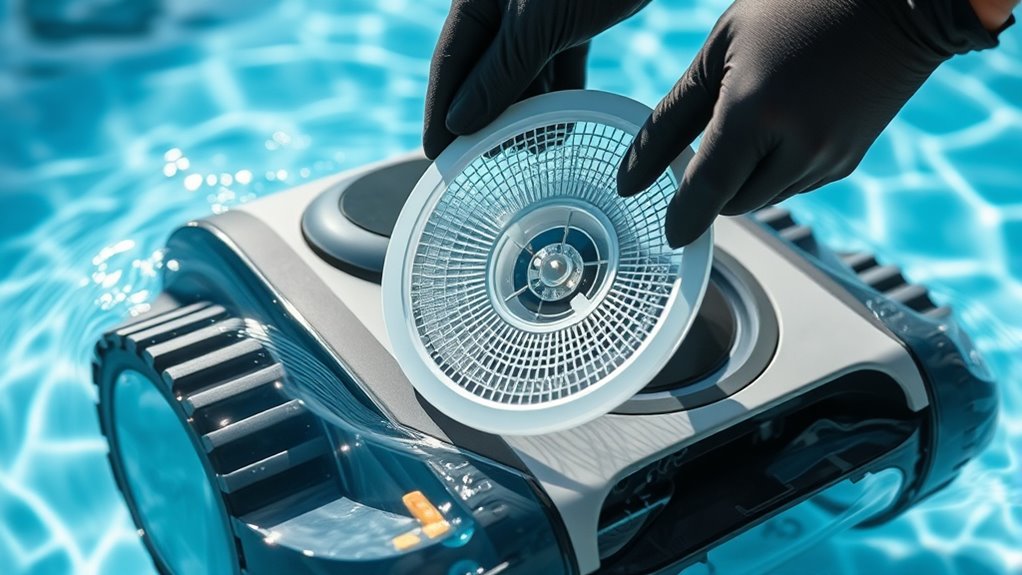
Regularly checking and cleaning your robotic pool cleaner’s filter is essential to maintaining its ideal performance. A clean filter ensures efficient debris removal and prolongs your device’s lifespan. Start by removing the filter housing and inspecting the filter for dirt, leaves, or debris buildup. Rinse it thoroughly with a hose, paying attention to the fine mesh. While you’re at it, check the gasket for cracks or damage to prevent leaks, and consider replacing the filter if it shows signs of wear. Regular filter maintenance prevents clogs and optimizes suction power. Additionally, understanding filter durability can provide insight into the longevity of replacement parts and when to schedule updates. Proper maintenance can also help avoid filter clogs, which can impair your cleaner’s operation. Regularly inspecting the seal and gasket helps maintain an effective water-tight fit and prevent leaks during operation. Staying informed about industry transformations can help you adopt the latest innovations in robotic pool cleaning. Remember, timely filter replacement keeps your cleaner working smoothly. Incorporate these steps into your routine to keep your pool spotless and your robotic cleaner operating at peak performance.
Inspecting the Brushes and Scrubbing Components

Start by checking the brush wear indicators to see if your brushes are thinning or damaged. Next, clean the scrubbing components thoroughly to remove any debris or buildup. Regular inspections guarantee your cleaner works efficiently and keeps your pool sparkling. Remember to inspect the wax types and other materials used in your pool cleaner to ensure optimal performance. Additionally, examining the suspension components can help maintain smooth operation and prevent potential issues. Incorporating HEPA filtration and other advanced features can further improve your cleaner’s effectiveness and longevity, especially considering the latest innovations in filtration systems and their impact on pool cleaning efficiency. Regularly updating your performance upgrades can also help maintain peak cleaning performance over time.
Brush Wear Indicators
Monitoring the condition of your robotic pool cleaner’s brushes and scrubbing components is essential to maintain ideal performance. Many models feature brush wear indicator lights that alert you when brushes are nearing the end of their lifespan. When these indicator lights turn on, it’s a clear sign to inspect the brushes for signs of wear or damage. You might notice:
- Reduced cleaning efficiency
- Visible signs of brush fraying or thinning
- Uneven brush rotation
- Lingering debris or residue after cleaning
Pay close attention to these signs, as worn brushes compromise cleaning power. If the indicator lights activate, it’s time to replace or service the brushes to ensure your cleaner continues to operate effectively and prevents damage to other components. Also, understanding the types of connectors used in your devices can help when replacing or upgrading parts related to your pool cleaner’s electronics. Regular inspection and timely replacement of worn brushes help maintain the performance and extend the lifespan of your robotic cleaner. Additionally, staying informed about AI safety measures can help you better understand the importance of maintaining reliable and safe robotic devices. Incorporating routine inspection into your maintenance schedule ensures optimal operation, which is crucial for maintaining efficiency and avoiding costly repairs.
Cleaning Scrubbing Components
Inspecting your robotic pool cleaner’s brushes and scrubbing components is a straightforward process that helps maintain ideal cleaning performance. Check the brushes for wear or damage; if they’re worn down or misshapen, it’s time for brush replacement. Inspect the scrubbing pads for debris buildup or fraying, which can hinder scrubbing pad maintenance. Clean or replace them as needed to guarantee peak scrubbing power. Use the table below to guide your inspection:
| Component | What to Look For |
|---|---|
| Brushes | Worn bristles, cracks, or missing parts |
| Scrubbing pads | Fraying, debris buildup, or tears |
| Attachments | Loose or broken parts |
| Rotation mechanism | Blockages or damage |
| Overall condition | Dirt or corrosion |
Regularly performing these inspections ensures your cleaning equipment remains in top condition, extending its lifespan and maintaining optimal performance. Incorporating routine maintenance into your schedule can prevent unexpected failures and improve overall efficiency.
Examining the Power Supply and Cables
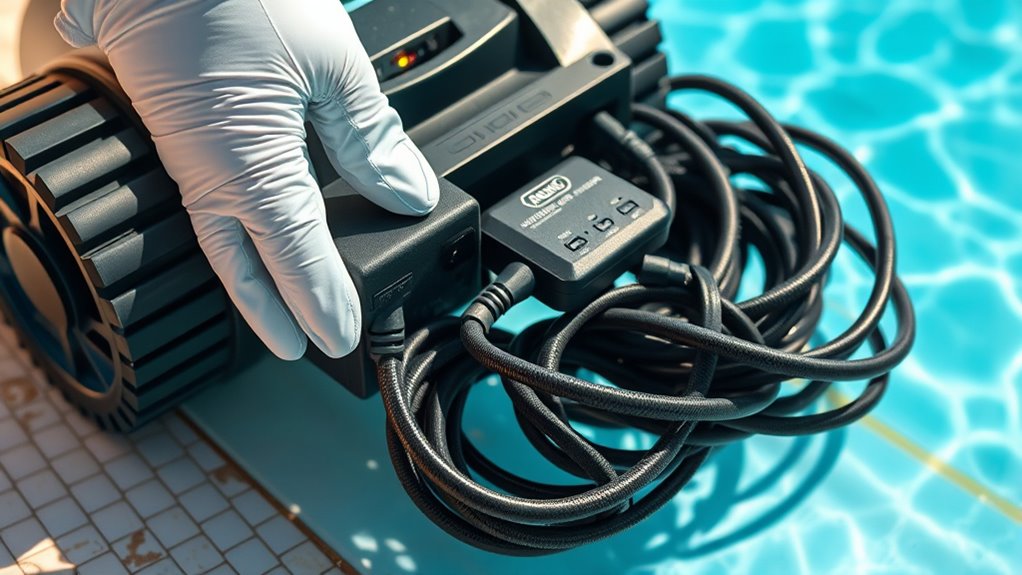
Start by checking the power cord connections to make certain they’re secure and undamaged. Then, inspect the power supply unit for any signs of wear or malfunction. Finally, test for power fluctuations to confirm your cleaner is receiving consistent energy.
Check Power Cord Connections
Have you checked if the power cord is securely plugged into both the electrical outlet and the robotic cleaner? Loose or damaged connections can cause power issues and prevent your cleaner from working properly. To verify everything is secure, inspect the connection points carefully.
- Make sure the power cord is fully inserted into the outlet without any gaps.
- Confirm the connection to the robotic cleaner is tight and free from debris.
- Look for any visible signs of damage or fraying on the power cord.
- Test the outlet with another device to rule out electrical issues.
Addressing connection issues early can save you time and prevent further damage. If the power cord isn’t firmly connected, your robotic pool cleaner may not power on or run intermittently.
Inspect Power Supply Unit
Since your robotic pool cleaner isn’t functioning properly, it’s important to examine the power supply unit and its cables for any issues. Check for power supply faults, such as burnt smells, unusual noises, or visible damage. Inspect the power supply for loose or damaged cable connections, ensuring they’re securely attached and free of corrosion or wear. Faulty connections can interrupt power flow, causing the cleaner to stop working or operate intermittently. If you notice any cracks, frays, or exposed wires in the cables or the power supply, replace or repair them immediately. Confirm that the power supply is plugged into a functioning outlet. Addressing these issues helps ensure your robotic cleaner receives consistent power and functions correctly.
Test for Power Fluctuations
How can you guarantee your robotic pool cleaner gets steady power? Testing for power fluctuations is essential to maintain electrical stability. Fluctuations can cause operational issues or damage. To check, inspect your power supply and cables thoroughly. Look for signs of wear, loose connections, or damage that might lead to inconsistent power. Using a multimeter can help you detect voltage irregularities. Visual cues can include flickering indicator lights or sudden stops in operation. Ensuring the power source remains stable prevents interruptions and prolongs your cleaner’s lifespan. By regularly testing for power fluctuations, you safeguard your device against electrical instability. Keep these points in mind:
- Check for loose or damaged cables
- Use a multimeter for voltage consistency
- Observe indicator lights during operation
- Ensure the power outlet provides stable voltage
Replacing or Repairing Worn-Out Parts
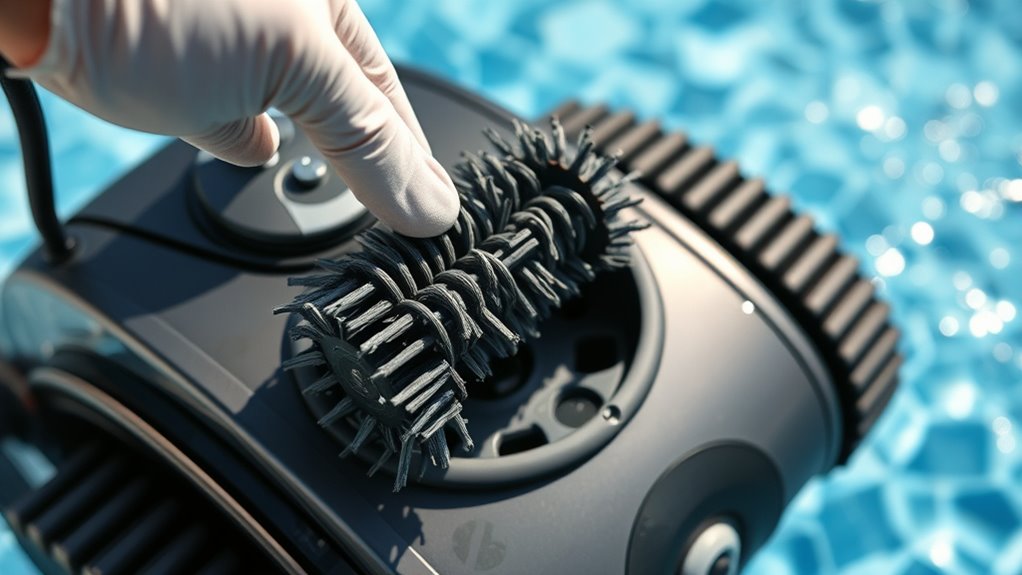
When your robotic pool cleaner starts to underperform or make unusual noises, it’s a clear sign that some parts may be worn out and need replacement or repair. First, identify the affected component, such as brushes, wheels, or the drive motor. Using the right replacement parts ensures your cleaner functions effectively again. For minor issues, repair techniques like cleaning or adjusting parts can extend their lifespan. If a part is damaged beyond repair, replacing it with the correct component is essential. Always consult your user manual or manufacturer’s instructions to ensure proper installation. Regularly inspecting and maintaining these parts helps prevent bigger problems down the line, saving you time and money while keeping your pool cleaner operating smoothly.
Scheduling Routine Maintenance for Longevity
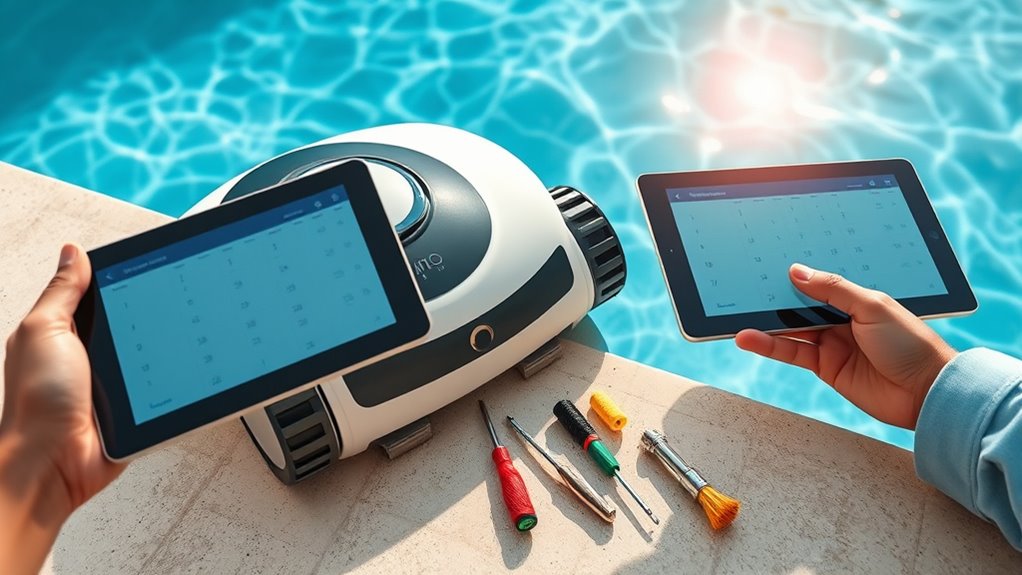
Regularly scheduling maintenance for your robotic pool cleaner is essential to keep it operating at peak performance and extend its lifespan. Consistent upkeep prevents buildup and ensures it functions smoothly over time. During routine maintenance, you’ll want to:
- Check and clean filters to remove debris and maintain suction
- Inspect brushes and wheels for wear, replacing as needed
- Evaluate spa maintenance needs to keep the cleaner effective in hot tub environments
- Test and adjust pool chemistry to prevent corrosion and buildup
Keeping the water balanced helps protect your cleaner’s components, while regular filter cleaning keeps it running efficiently. By sticking to a maintenance schedule, you’ll reduce the chances of breakdowns and enjoy a cleaner pool with less effort. Proper care translates to longer-lasting performance and more enjoyable swimming.
Troubleshooting Common Performance Issues
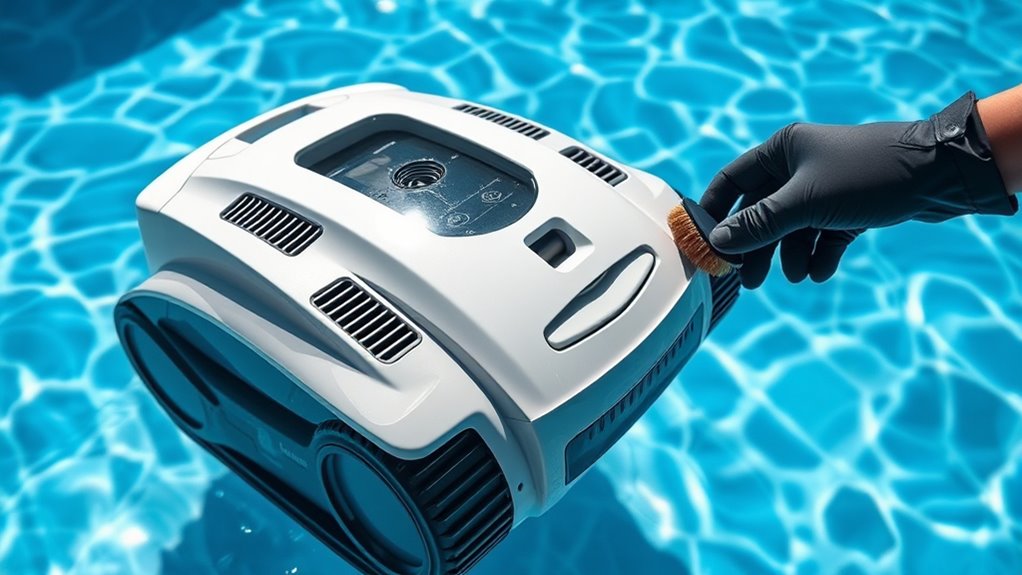
If your robotic pool cleaner isn’t performing as it should, identifying and addressing common issues can save you time and frustration. One frequent problem is poor robotic cleaning coverage, often caused by tangled brushes or debris blocking the filters. Check and clean these parts regularly for excellent pool maintenance. If the cleaner isn’t moving properly, ensure the wheels or tracks aren’t obstructed and that the power supply is functioning correctly. Reduced suction or poor debris pickup may indicate a clogged filter or dirty brushes. Additionally, if the robot isn’t charging, inspect the charging cable and station for damage or loose connections. Troubleshooting these issues promptly helps maintain effective robotic cleaning, keeps your pool cleaner longer, and ensures your pool stays sparkling clean without unnecessary service calls.
Storing Your Robotic Cleaner Properly During Off-Season
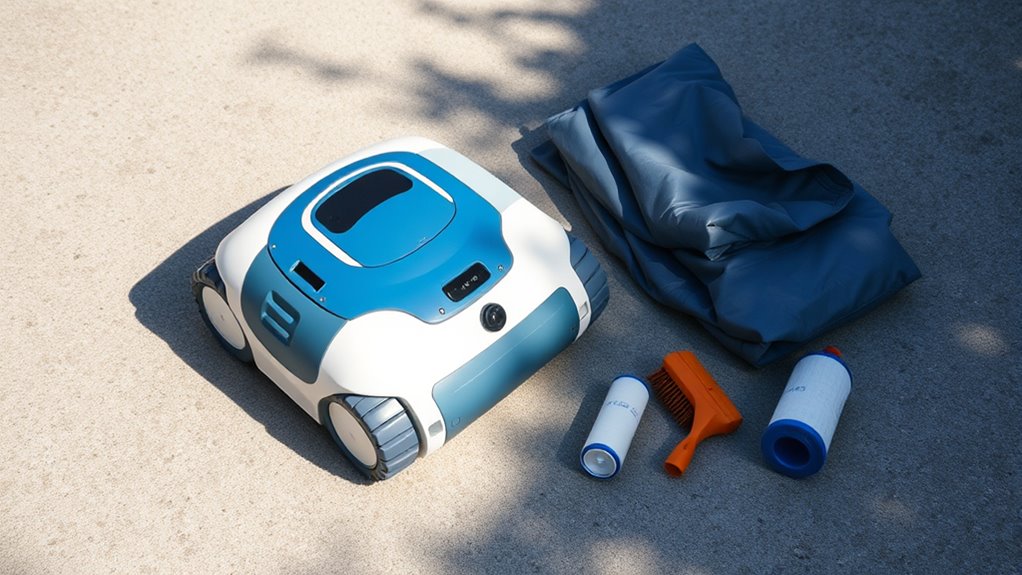
Properly storing your robotic pool cleaner during the off-season helps extend its lifespan and guarantees it’s ready to work when you need it again. Follow these storage tips to ensure maximum seasonal maintenance:
- Clean the filter and brushes thoroughly to prevent mold and debris buildup.
- Charge the battery fully before storing, then disconnect it to avoid corrosion.
- Store the cleaner in a cool, dry place away from direct sunlight or extreme temperatures.
- Keep it in a breathable bag or container to prevent dust accumulation and damage.
Frequently Asked Questions
How Often Should I Schedule Professional Servicing for My Robotic Pool Cleaner?
You should schedule professional servicing for your robotic pool cleaner at least once a year, especially if you do a lot of DIY maintenance. Regular professional check-ups help keep it running efficiently and protect your warranty. Keep an eye on signs like reduced cleaning performance or strange noises, which indicate it’s time for expert service. Regular maintenance ensures longevity and peak performance, giving you peace of mind during pool season.
Can I Replace Parts Myself, or Should I Always Seek Professional Help?
Think of your robotic pool cleaner as a trusted partner in pool maintenance. When it comes to DIY repairs, you can handle simple parts like brushes or filters, but for complex issues or electrical components, professional servicing is your safest bet. Trying to replace difficult parts yourself might cause more harm than good. Always weigh the risk, and don’t hesitate to seek expert help to keep your cleaner running smoothly.
What Are the Signs of Internal Motor Failure in a Robotic Cleaner?
You’ll notice signs of internal motor failure if your robotic cleaner struggles to move, makes unusual noises, or stops unexpectedly. Motor diagnostics can reveal issues like overheating or inconsistent performance. Internal component wear, such as worn brushes or burnt-out coils, also influences functionality. If these symptoms appear, it’s a sign you need to inspect or replace the motor, or seek professional help to ensure your cleaner operates efficiently.
Is It Necessary to Calibrate the Cleaner After Cleaning or Repairs?
Did you know that proper calibration can boost your robotic cleaner’s efficiency by up to 20%? After cleaning or repairs, it’s essential to follow calibration procedures to guarantee ideal performance. This involves operational adjustments like resetting sensors and recalibrating navigation systems. Skipping this step might cause the cleaner to miss spots or operate inefficiently. So, yes, calibrating your robotic pool cleaner after maintenance helps it work smoothly and saves you time and effort.
How Do Environmental Factors Affect the Maintenance Schedule of My Robotic Cleaner?
Environmental factors like water chemistry and algae prevention directly impact your robotic pool cleaner’s maintenance schedule. If your water has high pH levels or frequent algae blooms, you’ll need to clean your device more often to prevent buildup and guarantee ideal performance. Regularly check water chemistry and algae levels, and adjust your cleaning routine accordingly. Proper maintenance keeps your cleaner functioning smoothly and extends its lifespan.
Conclusion
Regularly servicing your robotic pool cleaner can extend its lifespan and keep your pool sparkling. Did you know that neglecting maintenance can reduce its efficiency by up to 30%? By checking filters, brushes, and cables monthly, you prevent costly repairs and ensure peak performance. Staying proactive with routine care not only saves money but also guarantees a cleaner, healthier pool season after season. Don’t wait for issues—service now for hassle-free swimming all year round.
